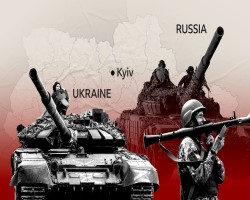SSC Current Affairs
| International Relations |
|---|
|
|
|
Why in the news?
Donald Trump on December 9th 2024 pushed Russian leader Vladimir Putin to act to reach an immediate cease-fire with Ukraine, describing it as part of his active efforts as president-elect to end the war despite being weeks from taking office. Zelensky and Ukraine would like to make a deal," Trump wrote on social media, referring to Ukraine's president, Volodymyr Zelenskyy. What is the Background of Russia-Ukraine conflict? Ukraine and Russia share hundreds of years of cultural, linguistic and familial links. For many in Russia and in the ethnically Russian parts of Ukraine, the shared heritage of the countries is an emotional issue that has been exploited for electoral and military purposes. As part of the Soviet Union, Ukraine was the second-most powerful Soviet republic after Russia, and was crucial strategically, economically and culturally. Why Russia invaded Ukraine? Russia wanted a guarantee Ukraine can never join NATO Russia's main demand was a commitment from NATO to end its further expansion into former Soviet republics — especially Ukraine. Russia wants NATO arms out of Eastern Europe Russia wants NATO to stop deploying its weapons and forces in countries in Central and Eastern Europe that joined the alliance after 1997. Russia wants a ban on NATO missiles within striking distance Russia has nervously watched as NATO has demonstrated it can deepen its involvement in Ukraine — providing weapons and training. NATO missiles on Ukrainian soil might pose serious threat to Russia’s security. Russia wants autonomy for eastern Ukraine Russia says Ukraine must meet its obligations under 2015 agreements. The peace deal, known as the Minsk agreements, was signed to end the fighting between Ukraine's army and pro-Russian separatists in eastern Ukraine. The Minsk agreements also provided additional autonomy to the separatist Russian-speaking territories in the Donbas. Invasion of Crimea: Russia seized Crimea from Ukraine in what was the first time a European country annexed territory from another country since World War-2. The annexation of Crimea from Ukraine followed a Russian military intervention in Crimea that took place in the aftermath of the 2014 Ukrainian revolution and was part of wider unrest across southern and eastern Ukraine. The invasion and subsequent annexation of Crimea have given Russia a maritime upper hand in the region. Sea of Azov clash-Post Crimea’s annexation, Russia and Ukraine fought over the Sea of Azov. It is connected to the Black Sea by a narrow strait. Russia built a bridge over the Kerch strait and blocked Ukraine’s ships from passing through. Russian backed rebels: Russia has been criticised for its involvement in the Donetsk and Luhansk regions in eastern Ukraine, it acknowledged that the two regions of Donbass region as independent republics which aggravated the issue. Migration crisis- Belarus, Russian ally sent many migrants to the border of Poland (EU member), it caused issues for Poland and EU. Ukraine’s pro-West stand: Ukraine became independent from Russia after the collapse of Soviet Union, Russia described Ukraine as a puppet of West. Current Situation: Russia is seeking assurances from the US that Ukraine will not be inducted into NATO. However, the US is not prepared to give any such assurance. This has left the countries in a stand-off, with tens of thousands of Russian troops ready to invade Ukraine. Russia is keeping the tensions high at the Ukraine border in order to get sanctions relief and other concessions from the West. Any kind of military action by the US or EU against Russia would precipitate a major crisis for the whole world, and has so far not been mooted by any of the parties involved. India’s Stand: India did not join the Western powers’ condemnation of Russia’s intervention in Crimea and kept a low profile on the issue. In November 2020, India voted against a Ukraine-sponsored resolution in the United Nations (UN) that condemned alleged human rights violations in Crimea thereby backing old ally Russia on the issue. |
|
|
|
Useful information for all competitive exams:
North Atlantic Treaty Organization (NATO) The North Atlantic Treaty Organization (NATO), also called the North Atlantic Alliance, is an intergovernmental military alliance of 32 member states—30 European and 2 North American. Established in the aftermath of World War II, the organization implements the North Atlantic Treaty, signed in Washington, D.C., on 4 April 1949. Formation: 4 April 1949 (75 years ago) Type: Military alliance Headquarters: Brussels, Belgium Membership: 32 Countries ( Albania, Belgium, Bulgaria, Canada, Croatia, Czech Republic, Denmark, Estonia, Finland, France, Germany, Greece, Hungary, Iceland, Italy, Latvia, Lithuania, Luxembourg, Montenegro, Netherlands, North Macedonia, Norway, Poland, Portugal, Romania, Slovakia, Slovenia, Spain, Sweden, Turkey, United Kingdom, United States) Secretary General(14th): Mark Rutte (Dutch) Chair of the NATO Military Committee: Rob Bauer |
| >> More SSC Current Affairs |
